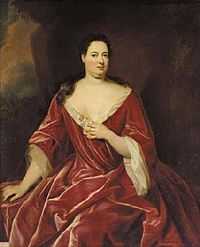Sophia von Kielmansegg, Countess of Darlington

Sophia Charlotte von Kielmansegg, Countess of Darlington and Countess of Leinster (1675 – 20 April 1725) was a German-born British courtier and a half-sister of George I of Great Britain.
Early life
Born Baroness Sophia Charlotte von Platen und Hallermund (probably in Osnabrück), she was the daughter of Clara Elisabeth von Meysenburg, Baroness von Platen und Hallermund (1648–1700) and Ernest Augustus, Elector of Hanover. Her mother's husband, Franz Ernst, Baron von Platen (1631–1709) was officially described as her father (as indeed he was in that, at the time, the child of a married woman was conclusively presumed to be the child of her husband) but the fact that she was the illegitimate daughter of the Elector was acknowledged at court. When her "father" was accorded a comital title in 1689, she became Countess Sophia.
Marriage
Sophia established a close relationship with her half-brother, who succeeded to the British throne as George I in 1714, but his mother, Electress Sophia, asserted that, 'to her certain knowledge', Countess Sophia was not one of George's mistresses. In 1701, she married Johann Adolf, Baron von Kielmansegg (1668–1717), Deputy Master of the Horse to George Louis and they had three sons and two daughters, the eldest of whom, Charlotte (1703–1782), married Emanuel Howe, 2nd Viscount Howe.
Life at the British court
When George Louis became King of Great Britain on the death of Queen Anne in 1714, Sophia and her family followed him to London. She mixed well with the king's British courtiers (who also assumed her to be one of the king's mistresses) but competed for influence with George's mistress, Melusine von der Schulenburg, and was disliked by the Princess of Wales, who 'thought her a wicked woman'. Sophia received many gifts from those seeking patronage; e.g. between 1715 and 1720 she received £9,545 from the Duke of Chandos and in 1720 was given £15,000 of stock by the South Sea Company, with a bonus of £120 for every point the stock rose above £154.
Peerage
When Melusine was created Duchess of Munster in 1716 and Duchess of Kendal in 1719, Sophia was said to have also campaigned for either an Irish or British peerage. This campaigning was taken for granted when in a newsletter of 14 November 1717, it was stated that she "came to town some weeks since on pretence to be with her husband...but as others say upon a difference with the Duchess of Munster." Her husband died a day later and his illness, not her rivalry with the Duchess, was more likely to be the reason for her return to London. Perhaps to counter the blow of the South Sea Bubble, she was created Countess of Leinster in the Peerage of Ireland in 1721 and Countess of Darlington and Baroness Brentford a year later in the Peerage of Great Britain, all life peerages. The letters patent for both titles had the king describe her as consanguineam nostram (English: of our common blood) and her coat of arms included the arms of Brunswick with a bar sinister to denote her as an illegitimate daughter of an elector of Hanover.
Death and legacy
The countess died at her home in St. James's in 1725 and was buried in Westminster Abbey. Walpole reminisced of:
| “ | being terrified at her enormous figure...Two fierce black eyes, large & rolling, beneath two lofty arched eyebrows, two acres of cheeks spread with crimson, an ocean of neck that overflowed & was not distinguished from the lower part of her body, and no part restrained by stays. | ” |
Although described by historians as 'the Elephant' who competed with 'the Maypole' (Melusine), modern historians, especially Ragnhild Hatton attribute her as a valued courtier of the king and stating she was not as obese as early works suggested.
Diana, Princess of Wales, was one of her descendants.